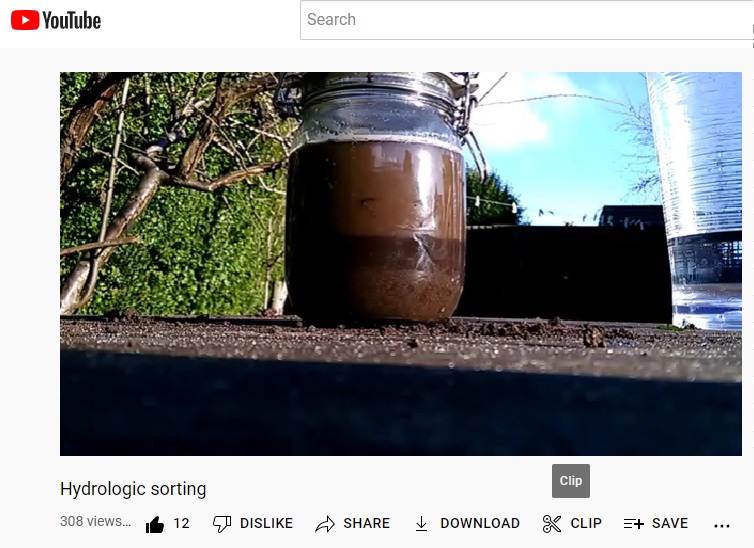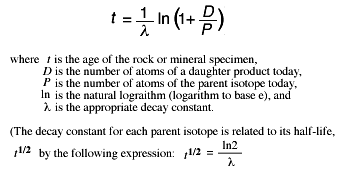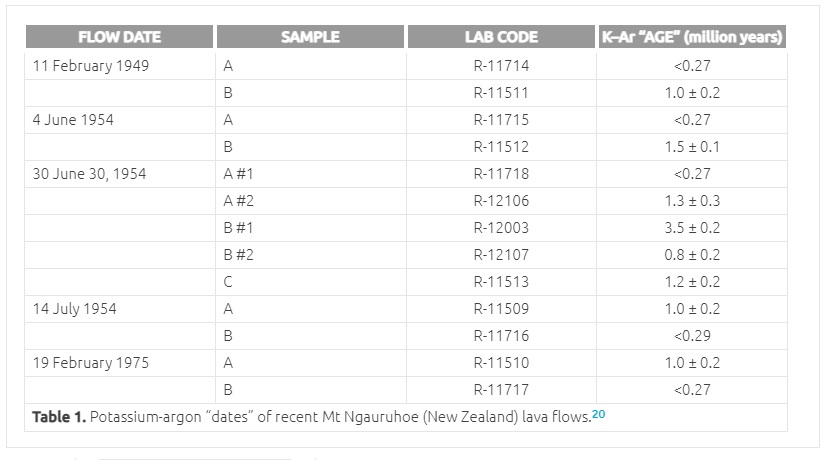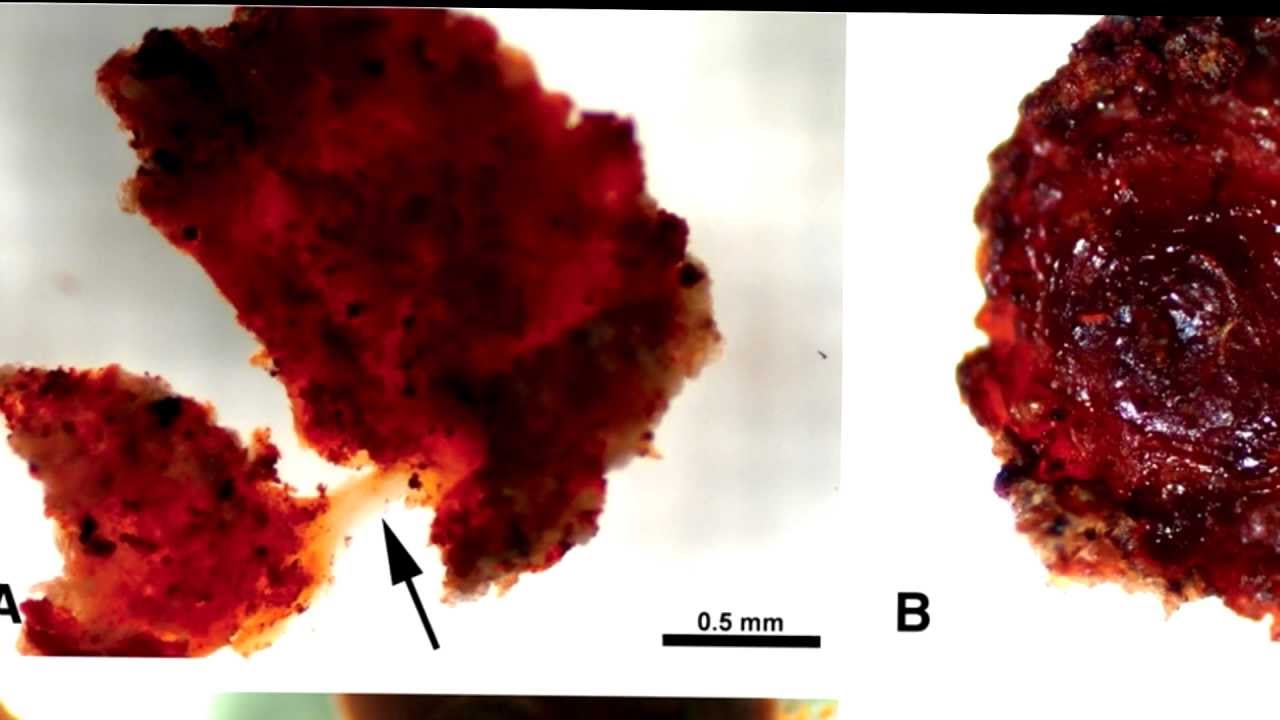It looks like you're using an Ad Blocker.
Please white-list or disable AboveTopSecret.com in your ad-blocking tool.
Thank you.
Some features of ATS will be disabled while you continue to use an ad-blocker.
share:
Mt. Saint Helen was a perfect example of how fast things can form. The mini grand canyon it created took just hours. We also have C14 to help prove
the Earth is not millions of years old. Most likely around 8-12 thousand years. Interesting enough The Bible backs up this time frame.
Fossils have been found showing a mother giving birth when she was fossilized, this confirms whatever fossilized them happened very quickly...maybe a flood?
Fossils have been found showing a mother giving birth when she was fossilized, this confirms whatever fossilized them happened very quickly...maybe a flood?
originally posted by: SeektoUnderstand
a reply to: cooperton
So when did dinosaurs exist? Allosaurus fossil
Alongside our ancestors. There's countless depictions of dinosaur both in literature and art from cultures all around the world before the word 'dinosaur was even invented (depictions of dinosaurs in this link). There's also soft tissue in dinosaur, and human footprints have been found in the same strata as dinosaur footprints:
link
All the data corroborates to a much younger timeline for biological life.
Saying “rocks don’t take millions of years to form” is one of the logical fallacies because it isn’t specific; *some* rocks can form instantly, while others do in fact take millions of years…..
So it is a logical fallacy to say rocks do take millions of years to form. Yet this is what most are led to believe. Ask the average person on the streets how soon can a rock form and they'll probably say millions of years. Could a rock take longer to form? Sure, maybe under minimal heat and pressure. But all the geological structures exhibited around the world could have formed quickly given the right event. Bricks, which are mudrock or metamorphic rock depending on the components, can form in days! I also showed in the OP that the largest stalactite on earth could have formed in less than 1000 years. So why the need for this million year narrative? It's so it can fit the theorized evolutionary timeline. It's self-serving logic.
originally posted by: nugget1
The Great Mosque of Djenné would turn to dust if it wasn't re-surfaced every year, so while a hardened brick I don't think it really meets the definition of a rock.
It's not as strong as naturally formed rocks but it's still considered mudrock. Bricks can last over 500+ years. Larger bricks even longer, look at the pyramids.
originally posted by: Degradation33
We all know this. And can absolutely affirm said example of granite was radio isotope dated to at least the beginning of The Permian Age, 300 million years ago. That granite slab cutting board may have crystalized 1.7 billion years ago though.
Isotope decay doesn't lie.
But a respectable dating lab dated a 50 year old volcanic to 3.2 million years. Isotopic decay is a consistent science, but you need to know the initial concentration to be able to determine time elapsed in the half-life equation:

Isotope decay has many variables that disallow a consistently accurate reading. determining initial concentration is the most difficult of these variables. Scientists often assume the initial concentration is 100-0, which is rash speculation given that we never find pure samples of anything in nature. Not even gold. So why assume the 100-0 ratio? Because it gives the oldest dates, which is what they want because it increases their likelihood of being published.
edit on 23-6-2022 by cooperton because: (no reason given)
edit on 23-6-2022 by cooperton because: (no reason given)
originally posted by: MPoling
Mt. Saint Helen was a perfect example of how fast things can form. The mini grand canyon it created took just hours. We also have C14 to help prove the Earth is not millions of years old. Most likely around 8-12 thousand years. Interesting enough The Bible backs up this time frame.
Of all the radiometric dating methods, C14 has a relatively accurate estimate on initial isotopic ratios. We need to know this ratio to determine the amount of time elapsed. Although we can't know it for sure, we can estimate that the C14 ratios in the atmosphere have been constant throughout time. This is fallacious, but it can at least get us in the ball-park of what the initial C14 concentration was. For example, if atmospheric C14 ratios were actually smaller in the past, then all C14 dating will give a result saying it is older than it actually is.
Fossils have been found showing a mother giving birth when she was fossilized, this confirms whatever fossilized them happened very quickly...maybe a flood?
Yeah exactly. Checkout this simple video where a guy shakes up a jar of soil with water to emulate a flood. Soon after the sediment forms layers, which in theory would be how many of the geological layers formed after the flood:
Here's a pic of the sediment after it settles:

edit on 23-6-2022 by cooperton because: (no reason given)
a reply to: cooperton
Need a road map for that one. Watch out for rhetorical strawmen. Initial concentrations? No pure examples in nature? It sounds pretty I guess.
Those never really come up in the age equation.
I will just keep parroting that USGS link..
The age equation. Plug and play.

Difficult does not mean we can't. Especially with potassium in igneous rock.
In the used example of K-40 -> Ar-40: If a sample has a very low concentration of argon, you can accurately know "how far along in its decay it is". It is a much younger rock than one with a lot higher concentration of argon isotopes. In simple terms if a sample is roughly 50% potassium-40 isotopes to all daughter isotopes then you can date that specimen to around 1.25 billion years.
* Potassium-40 is interesting because it also decays into Calcium-40. But its known what percent decays into which. So its an overall comparison thing.
Argon-40's entire presence on earth (and in atmosphere) is produced by the decay of potassium-40 in deep underground rock formation. At the point when that granite crystalizes (cant cool or solidify anymore) there isn't any decay-produced argon yet if that sample was excavated and tested right at that point... Which is when it is many many miles underground and inaccessible. Earth likes recycling it's crust and you have to wait for that granite to reach the surface. After a lot of decay has already occured from when it crystalized.
Why should we compress Earth's geological timescale 720,000 times over to hold alive a FULLY discredited 6000 year narrative?
If I held to an anthropomorphic deity I would thank that god for creating amazingly complex atomic structures that decay in such a constant and known way that it allows me to precisely learn about my world. Like a better roadmap for the terrain. Just had to decode it all. That's just me though.
Need a road map for that one. Watch out for rhetorical strawmen. Initial concentrations? No pure examples in nature? It sounds pretty I guess.
Those never really come up in the age equation.
I will just keep parroting that USGS link..
The age equation. Plug and play.

Dating rocks by these radioactive timekeepers is simple in theory, but the laboratory procedures are complex. The numbers of parent and daughter isotopes in each specimen are determined by various kinds of analytical methods. The principal difficulty lies in measuring precisely very small amounts of isotopes.
The potassium-argon method can be used on rocks as young as a few thousand years as well as on the oldest rocks known. Potassium is found in most rock-forming minerals, the half-life of its radioactive isotope potassium-40 is such that measurable quantities of argon (daughter) have accumulated in potassium-bearing minerals of nearly all ages, and the amounts of potassium and argon isotopes can be measured accurately, even in very small quantities. Where feasible, two or more methods of analysis are used on the same specimen of rock to confirm the results.
Difficult does not mean we can't. Especially with potassium in igneous rock.
In the used example of K-40 -> Ar-40: If a sample has a very low concentration of argon, you can accurately know "how far along in its decay it is". It is a much younger rock than one with a lot higher concentration of argon isotopes. In simple terms if a sample is roughly 50% potassium-40 isotopes to all daughter isotopes then you can date that specimen to around 1.25 billion years.
* Potassium-40 is interesting because it also decays into Calcium-40. But its known what percent decays into which. So its an overall comparison thing.
Argon-40's entire presence on earth (and in atmosphere) is produced by the decay of potassium-40 in deep underground rock formation. At the point when that granite crystalizes (cant cool or solidify anymore) there isn't any decay-produced argon yet if that sample was excavated and tested right at that point... Which is when it is many many miles underground and inaccessible. Earth likes recycling it's crust and you have to wait for that granite to reach the surface. After a lot of decay has already occured from when it crystalized.
Why should we compress Earth's geological timescale 720,000 times over to hold alive a FULLY discredited 6000 year narrative?
If I held to an anthropomorphic deity I would thank that god for creating amazingly complex atomic structures that decay in such a constant and known way that it allows me to precisely learn about my world. Like a better roadmap for the terrain. Just had to decode it all. That's just me though.
edit on 24-6-2022 by Degradation33 because: (no reason given)
originally posted by: MPoling
Mt. Saint Helen was a perfect example of how fast things can form. The mini grand canyon it created took just hours. We also have C14 to help prove the Earth is not millions of years old. Most likely around 8-12 thousand years. Interesting enough The Bible backs up this time frame.
Fossils have been found showing a mother giving birth when she was fossilized, this confirms whatever fossilized them happened very quickly...maybe a flood?
where exactly does the bible back up a 8-12 thousand year old earth?
this should be good
originally posted by: visitedbythem
The other lie is about dinosaurs being millions of years old. They have found soft tissue in dino remains.
NO.
'they'.
haven't.
originally posted by: cooperton
So it is a logical fallacy to say rocks do take millions of years to form.
NO.
It is intellectually dishonest to ask the question without specifying what kind of rocks you are talking about.
Some rocks form almost instantaneously, some rocks form very slowly indeed.
The only one that is 'leading some to believe' something is you. YOU are encouraging and misleading folks to mistrust their own experience of what they learned in school (because this stuff is taught in every school curriculum) and perhaps haven't thought about in years.
This process you are engaged in is called "GASLIGHTING" - and it is not only dishonest, it is morally inexcusable.
originally posted by: Akragon
originally posted by: MPoling
Mt. Saint Helen was a perfect example of how fast things can form. The mini grand canyon it created took just hours. We also have C14 to help prove the Earth is not millions of years old. Most likely around 8-12 thousand years. Interesting enough The Bible backs up this time frame.
Fossils have been found showing a mother giving birth when she was fossilized, this confirms whatever fossilized them happened very quickly...maybe a flood?
where exactly does the bible back up a 8-12 thousand year old earth?
this should be good
-----------------
I wont go through each person but if you take Adam - Jesus you will have your math.
originally posted by: MPoling
originally posted by: Akragon
originally posted by: MPoling
Mt. Saint Helen was a perfect example of how fast things can form. The mini grand canyon it created took just hours. We also have C14 to help prove the Earth is not millions of years old. Most likely around 8-12 thousand years. Interesting enough The Bible backs up this time frame.
Fossils have been found showing a mother giving birth when she was fossilized, this confirms whatever fossilized them happened very quickly...maybe a flood?
where exactly does the bible back up a 8-12 thousand year old earth?
this should be good
-----------------
I wont go through each person but if you take Adam - Jesus you will have your math.
right... and theres more then one geneology in the bible.... First attempted in the dark ages by a bishop named Usher... it wasn't accurate back then.... and it isn't even close now
so no the bible doesn't give the age of the earth.... anywhere
originally posted by: Degradation33
a reply to: cooperton
Need a road map for that one. Watch out for rhetorical strawmen. Initial concentrations? No pure examples in nature? It sounds pretty I guess.
Those never really come up in the age equation.
I will just keep parroting that USGS link..
The age equation. Plug and play.
You can tell by the equation that they are assuming the initial daughter-parent isotopic ratio was 0. If you put 0 for the current day number of daughter atoms, then time elapsed approximates to 0. So they're saying here that at time 0, "initial concentration", was 0-100. This doesn't happen in nature.
This was shown by fresh volcanic rock having nowhere near such a ratio. If fresh volcanic rock is dated as 3.2 million years old, then the dating method is about .001% accurate. Not good.

originally posted by: rnaa
NO.
'they'.
haven't ffound soft tissue in dinosaur bones/quote]
Yes they did
They're even finding ways to try to explain how soft tissue could persist for millions of years. So if they didn't find it, why would they be trying to explain it?
It looks like you're in denialedit on 25-6-2022 by cooperton because: (no reason given)edit on 25-6-2022 by cooperton because: (no reason given)
a reply to: Degradation33
Why are you focusing on discrediting an aspect of your own projection on the OP? The OP doesn’t discuss a 6000 year timeline for the earth, God isn’t mentioned once either but you are hyper fixated on that. Seems like it’s important to you to, what’s up with that?
Why are you focusing on discrediting an aspect of your own projection on the OP? The OP doesn’t discuss a 6000 year timeline for the earth, God isn’t mentioned once either but you are hyper fixated on that. Seems like it’s important to you to, what’s up with that?
originally posted by: cooperton
Yes they did
They're even finding ways to try to explain how soft tissue could persist for millions of years. So if they didn't find it, why would they be trying to explain it?
It looks like you're in denial
Ahh. So they have. Cool. I hadn't seen that before. Ain't science wonderful?
Here's a "Stated Clearly" cartoon explaining the phenomenon.
And an even new paper showing that the soft tissue found in the dinosaur bones may yet be explained by laboratory cross-contamination.
A fossil protein chimera; difficulties in discriminating dinosaur peptide sequences from modern cross-contamination
So there is still nothing certain about it.
But what does this have to do with how fast rocks form?
edit on 27/6/2022 by rnaa because: (no reason given)
originally posted by: rnaa
Ahh. So they have. Cool. I hadn't seen that before. Ain't science wonderful?
Here's a "Stated Clearly" cartoon explaining the phenomenon.
And an even new paper showing that the soft tissue found in the dinosaur bones may yet be explained by laboratory cross-contamination.
A fossil protein chimera; difficulties in discriminating dinosaur peptide sequences from modern cross-contamination
So there is still nothing certain about it.
But what does this have to do with how fast rocks form?
If the organisms that are present in these rock layers have soft tissue still intact, then it corroborates with the rock itself being younger than was previously believed. Scientists will try to explain away soft tissue preservation in dinosaurs, but for eyes to see it is clear that the currently accepted timeline is off. Mary Schweitzer even found collagen that was still exhibiting stretchiness in the dinosaur bone. It is clear these dinosaur remains are much younger than we have been told, and so are the rocks around them.
evidence for the co-existence of humans and dinosaurs
new topics
-
racist rant, but she made the arguement to get rid of DEI
US Political Madness: 40 minutes ago -
Well we know Putins ICBMs won't fail in their silos
World War Three: 54 minutes ago -
Why isn't Psychiatry involved?
Social Issues and Civil Unrest: 7 hours ago -
Help in song interpretation
Music: 8 hours ago -
FEMA Head Admits Agency Skipped 20 Homes with Trump Signs
Mainstream News: 11 hours ago
top topics
-
FEMA Head Admits Agency Skipped 20 Homes with Trump Signs
Mainstream News: 11 hours ago, 15 flags -
Yet another Hack...
Rant: 12 hours ago, 13 flags -
Gaetz ethics investigation results "hacked".
US Political Madness: 16 hours ago, 11 flags -
Well we know Putins ICBMs won't fail in their silos
World War Three: 54 minutes ago, 5 flags -
Why isn't Psychiatry involved?
Social Issues and Civil Unrest: 7 hours ago, 4 flags -
racist rant, but she made the arguement to get rid of DEI
US Political Madness: 40 minutes ago, 3 flags -
Help in song interpretation
Music: 8 hours ago, 1 flags
active topics
-
Well we know Putins ICBMs won't fail in their silos
World War Three • 15 • : andy06shake -
Post A Funny (T&C Friendly) Pic Part IV: The LOL awakens!
General Chit Chat • 7804 • : baddmove -
FEMA Head Admits Agency Skipped 20 Homes with Trump Signs
Mainstream News • 12 • : YourFaceAgain -
How Long have You been Alive?
General Chit Chat • 32 • : Oldcarpy2 -
Russia Ukraine Update Thread - part 3
World War Three • 6841 • : andy06shake -
WATCH LIVE: US Congress hearing on UFOs, unidentified anomalous phenomena
Aliens and UFOs • 151 • : Lazy88 -
Well, here we go red lines crossed Biden gives the go ahead to use long range missiles
World War Three • 314 • : ufoorbhunter -
racist rant, but she made the arguement to get rid of DEI
US Political Madness • 0 • : network dude -
Why isn't Psychiatry involved?
Social Issues and Civil Unrest • 7 • : BrucellaOrchitis -
Kentucky goes medical marijuana Jan 1 2025
Other Current Events • 27 • : 38181

